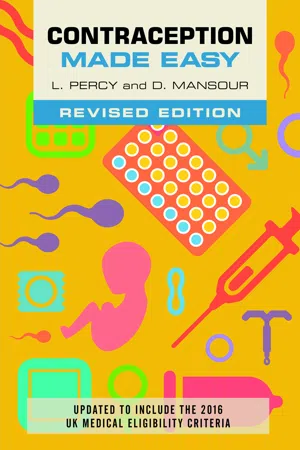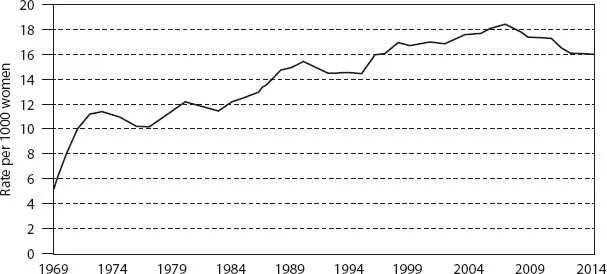
- 170 pages
- English
- ePUB (mobile friendly)
- Available on iOS & Android
Contraception Made Easy, revised edition
About this book
Highly Commended in the 2016 BMA Medical Book Awards!
From reviews:
"…undoubtedlythe best feature is the user-friendly and consistent nature of the format. Eachmethod of contraception has a dedicated chapter with an identical outlineshowcasing factual and practical content using bulleted text, tables andpictograms…. The book would be useful for medical students that are 'new' tothe subject as the outline of the chapters lends itself to seamless grasping ofnew information. However, the practical application of the factual informationis ideal for both gynaecological and family planning trainees, nurses that workwithin the field and general practitioners." Ulster Medical Journal 2016:85(3):211
This revised edition has been updated to include the 2016 UK MedicalEligibility Criteria for contraceptive use, as well as other updates. It helpshealthcare professionals to provide up to date and practical guidance on allthe commonly used contraceptive methods:
-
combined oral contraceptive (COCs), patches, andvaginal rings
-
progestogen-only pills (POPs), progestogen-onlyinjectables and implants
-
copper intrauterine devices (IUDs) and the levonorgestrelIUS
-
diaphragms, cervical caps, and male and femalecondoms
-
natural fertility awareness advice/kits
-
emergency contraception
-
male and female sterilisation.
ContraceptionMade Easy is the ideal practical reference guide for GPs and otherhealthcare professionals involved in the provision of contraceptive advice.
Laura Percy is a Specialist Registrar in Community Sexual and Reproductivehealth. Diana Mansour is a Consultant in Community Gynaecology and ReproductiveHealthcare and Head of the Integrated Sexual Health Services for Newcastle uponTyne, UK. She is also a Faculty Officer and Treasurer for the Faculty of Sexualand Reproductive Health Care, UK.
Frequently asked questions
- Essential is ideal for learners and professionals who enjoy exploring a wide range of subjects. Access the Essential Library with 800,000+ trusted titles and best-sellers across business, personal growth, and the humanities. Includes unlimited reading time and Standard Read Aloud voice.
- Complete: Perfect for advanced learners and researchers needing full, unrestricted access. Unlock 1.4M+ books across hundreds of subjects, including academic and specialized titles. The Complete Plan also includes advanced features like Premium Read Aloud and Research Assistant.
Please note we cannot support devices running on iOS 13 and Android 7 or earlier. Learn more about using the app.
Information
Chapter 1
Introduction
1.1 Introduction
1.2 Unplanned pregnancy

1.3 Provision of contraceptive services
1.4 UK Medical Eligibility Criteria for contraception
Table of contents
- Cover
- Half Title
- Title
- Copyright
- Contents
- Foreword
- About the authors
- Abbreviations
- 1 Introduction
- 2 The contraception consultation
- 3 Special groups
- 4 Combined hormonal contraception
- 5 Progestogen-only pill
- 6 Injectable contraception
- 7 Contraceptive implant
- 8 Intrauterine system
- 9 Copper intrauterine devices
- 10 Barrier methods
- 11 Fertility awareness
- 12 Male and female sterilization
- 13 Emergency contraception
- 14 STIs, safe sex and sexual assault
- 15 Unplanned pregnancy
- Appendix – Summary of the UKMEC for contraceptive use
- Index